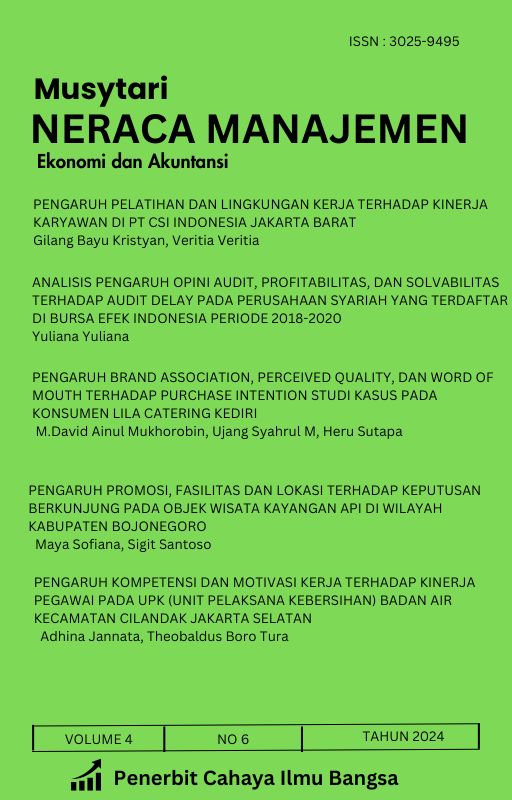ENHANCING CONTINUED INTENTION TO USE LAPERS BOT TELEGRAM THROUGH FACTORS INFLUENCING UTILITARIAN VALUE, CONFIRMATION, AND SATISFACTION
Main Article Content
Abstract
The telecommunications industry faces challenges in providing reliable applications for users. In the Customer Insight Management Division of PT Telekomunikasi Selular, the Lapers Bot Telegram is used as an alternative during U2020 maintenance, but its usage has declined significantly, indicating dissatisfaction with its performance, which could affect overall operations. This study analyzes the factors influencing employee preferences for both applications and provides recommendations to improve Lapers Bot Telegram for better effectiveness and operational efficiency. Using a quantitative approach with Partial Least Squares Structural Equation Modelling (PLS-SEM), data from 183 active Lapers Bot Telegram users was analyzed to examine variable relationships. The findings show that System Quality, Service Quality, Privacy and Security Concerns, Performance Expectancy, Facilitating Conditions, Utilitarian Value, Confirmation, Satisfaction, and Continued Intention to Use significantly influence the use of Lapers Bot Telegram, while Social Influence on Confirmation, Service Quality on Confirmation, and Information Quality on Confirmation do not. These insights help evaluate Lapers Bot Telegram’s role in supporting employee performance and guide the development of more efficient applications to enhance user satisfaction and operational effectiveness.
Downloads
Article Details

This work is licensed under a Creative Commons Attribution-NonCommercial 4.0 International License.
This work is licensed under a Creative Commons Attribution-ShareAlike 4.0 International License.
References
A., Morissan M. dkk. (2017). Metode Penelitian Survei. Jakarta: Kencana.
Aam, Otto dan Dian. (2020). Pengaruh Pengembangan Karier terhadap Kinerja Pegawai PT PLN UPT SULSELRABAR. Jurnal Ilmiah Administrasita’ Prodi Administrasi Publik Universitas Muhammadiyah Sinjai, 11(1).
Abd Mukhid. (2021). Metodologi Penelitian Pendekatan Kuantitatif. Surabaya: Jakad Media Publishing.
Abdillah, W., & Jogiyanto. (2015). Partial Least Square (PLS) Alternatif Structural Equation Modeling (SEM) dalam Penelitian Bisnis. C.V Andi Offset.
Abdullah, T., & Tantri, F. (2019). Manajemen Pemasaran (1st ed.). Depok: PT. Rajagrafindo Persada.
Abdurrahman, & Trianasari, N. (2020). Pengaruh Product Features, Brand Name, Social Influence, Social Sacrifice Terhadap Purchase Intention Smartphone Samsung Di Indonesia. E-Proceeding Of Management, 7(1), 469–474.
Adzima, F., & Ariyanti, M. (2018). Analisis Faktor-Faktor Yang Mempengaruhi Minat Menggunakan Aplikasi Mobile Banking Pada Nasabah Bank Bri Purwakarta. eProceedings of Management, 5(2).
Afroze, Museera, Abid, Ghulam, Rehman, Saqib, Elahi, Natasha. (2021). Impact of privacy and security on E-banking loyalty: Mediating role of customer satisfaction and moderation of reliability. 7, 257-280.
Ahyar, Hardani et al. (2020). Buku Metode Penelitian Kualitatif & Kuantitatif.
Aisy, R. R. (2021). Pengaruh Digital Marketing Dan Brand Loyalty Terhadap Keputusan Pembelian Pada Konsumen Scarlett Whitening Di Instagram. Universitas Islam Negeri Malang.
Akhtar, M.A., Sarea, A., Khan, I., Khan, K.A. & Singh, M.P. (2023). The moderating role of gamification toward intentions to use mobile payments applications in Bahrain. PSU Research Review.
Ali, Faizan & Ali, Laiba & Gao, Zhaoyu & Terrah, Abraham & Turktarhan, Gozde. (2022). Determinants of user's intentions to book hotels: a comparison of websites and mobile apps. Aslib Journal of Information Management.
Aloysius Rangga Aditya Nalendra, d. (2021). Statistika Seri Dasar Dengan SPPS. Media Sains Indonesia.
Ariffin, S.K., Abd Rahman, M.F.R., Muhammad, A.M. & Zhang, Q. (2021). Understanding the consumer’s intention to use the e-wallet services. Spanish Journal of Marketing - ESIC, 25(3), 446-461.
Arikunto, S. (2010). Prosedur Penelitian Suatu Pendekatan Praktik. Jakarta: Rineka Cipta.
Arpaci, I., Yardimci Cetin, Y., & Turetken, O. (2015). Impact of Perceived Security on Organizational Adoption of Smartphones. Cyberpsychology, Behavior, and Social Networking.
Bhattacherjee, A. (2001). Understanding Information Systems Continuance: An Expectation-Confirmation Model. MIS Quarterly, 351-370.
Camilleri, M. A., & Camilleri, A. C. (2022). Learning from anywhere, anytime: Utilitarian motivations and facilitating conditions for mobile learning. Technology, Knowledge and Learning.
Camoiras-Rodriguez, Z. & Varela, C. (2020). The influence of consumer personality traits on mobile shopping intention. Spanish Journal of Marketing - ESIC.
Catherine, C., & Tjokrosaputro, M. (2023). Pengaruh Perceived Usefulness dan Confirmation terhadap Continuance Intention Pembelian Tiket Maskapai LCC: Dengan Satisfaction sebagai Mediator. Jurnal Manajerial Dan Kewirausahaan.
Chiu, W., Cho, H. & Chi, C.G. (2021). Consumers' continuance intention to use fitness and health apps: an integration of the expectation–confirmation model and investment model. Information Technology & People, 34(3), 978-998.
Christiono, Daniel Ivan. (2018). Analisis Pengaruh Performance Expectancy Dan Effort Expectancy Terhadap Behavioral Intention Pada Online Marketplace. Agora, 6(2).
Franque, Frank & Oliveira, Tiago & Tam, Carlos. (2021). Understanding the factors of mobile payment continuance intention: Empirical test in an African context. Heliyon, 7.
Freihat, A.F., Farhan, A., & Shanikat, M. (2019). Do board of directors´ characteristics influence firm performance? Evidence from the emerging market. Journal of Management Information and Decision Sciences, 22(2), 148-165.
Goetsch, D., & Davis, S. (2019). Quality Management For Organizational Excellence: Introduction to Total Quality (8th Edition). Printice Hall International.
Gulo, W. (2002). Metodologi Penelitian. Jakarta: PT. Gramedia Widiasarana Indonesia.
Gupta, Anil & Yousaf, Anish & Mishra, Abhishek. (2020). How pre-adoption expectancies shape post-adoption continuance intentions: An extended expectation-confirmation model. International Journal of Information Management, 52.
Hajli, Nick. (2015). Social commerce construct and consumer’s intention to buy. International Journal of Information Management.
Handayani, N., & Ariyanti, M. (2024). Factors affecting continuance intention in e-wallet use in Indonesia after COVID-19. Indonesian Journal of Multidisciplinary Science.
Hardani, dkk (2020). Metode Penelitian Kualitatif & Kuantitatif. Yogyakarta: CV. Pustaka Ilmu Grup.
Hidayanti, A., & Batu, R. L. (2021). Pengaruh Social Influence Terhadap Keputusan Mengikuti Program Melalui Kepuasan Pelayanan pada PERMATA-SAKTI 2020. YUME: Journal of Management, 4(3).
Hidayat, M., Aini, Q., & Fetrina, E. (2020). Penerimaan Pengguna E-Wallet Menggunakan UTAUT 2 (Studi Kasus). Jurnal Nasional Teknik Elektro Dan Teknologi Informasi, 9(3), 239–247.
Salwa, S., Hidayah, R. T., Maulida, A., Putri, A., Permana, N. S., & Larasati, M. (2022). INCREASED INTENTION TO USE THE APPLICATION THROUGH BRAND TRUST AND QUALITY OF SERVICE (Research Study on Users of the Dana E-Money Application). CENTRAL ASIA AND THE CAUCASUS, 23(1), 5006-5016. https://ca-c.org/CAC/index.php/cac/article/view/527.

